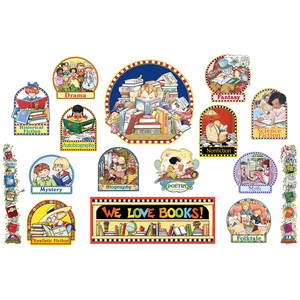 As a teacher, it is always a good idea to have interesting bulletin boards and displays around your room. These can satisfy a variety of needs, including the presentation of student work, the imparting of important information, and the reinforcement of key elements in the curriculum.
As a teacher, it is always a good idea to have interesting bulletin boards and displays around your room. These can satisfy a variety of needs, including the presentation of student work, the imparting of important information, and the reinforcement of key elements in the curriculum.
Classroom Information Bulletin Boards
Choose a bulletin board somewhere conspicuous in your classroom. Post important classroom management information. This information is helpful in establishing routines for children, parents, and other visitors. It is also vital information for substitute teachers.
Suggested information for the bulletin board includes the following:
- emergency information including evacuation route
- location of substitute folder
- daily schedule
- bell schedule
- lunch and rainy day lunch schedule
- class lists (without addresses and telephone numbers as these are sometimes confidential)
- class rules or expectations
- times that students leave the room for special services, such as assemblies
Use large headings or headliners to label bulletin boards so that they are noticeable and easy to read. You can also line up headliners along a wall or above a chalkboard or whiteboard to create borders and classroom calendars, or use them to label classroom centers, reading areas, and much more.
Inspiring Bulletin Boards
Bulletin boards can also be used as an opportunity to create a positive learning environment in the classroom. Use headliners with encouraging words to liven up classrooms and inspire students to do their best.
Featured Author/Artist Bulletin Board
Featuring an author or illustrator in an area of your classroom is very motivating for the students. It allows students to enjoy the talents of creative people. This type of bulletin board teaches students to appreciate the different styles of authors and artists.
 Some suggestions for this bulletin board include the following:
Some suggestions for this bulletin board include the following:
- name of author or artist
- facts about the person
- interest baskets with the featured author or artist’s works (Keep these interest baskets in the reading corner upon completion of featuring this author/artist. Children will enjoy going back to familiar works and will be on the lookout for more to add to the collection.)
- book jackets or prints of works
- cassette tapes to accompany author’s work
- duplicated copies or pages from an author/artist’s work and tracing paper (The children will trace and very closely recreate a particular drawing using various art media found in the art area.)
- a graph or tally sheet for students’ critiques of a book (Give two choices from which students will choose. Select, for example: Which book do you like better?; Which character would you like to be?; or Is this book reality or fantasy?)
Bulletin boards can be used for all sorts of purposes. Above all, the key to using bulletin boards is this:
EDUCATE, DO NOT JUST DECORATE. Never put up bulletin boards just because you have to they can be extremely effective teaching tools.
For more tips on how to use bulletin boards, check out the bulletin board section in the Jumbo Book of Teacher Tips and Timesavers.
